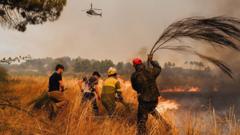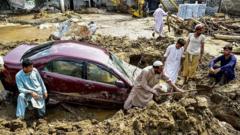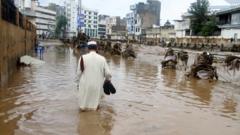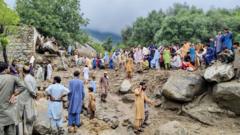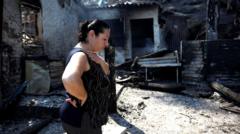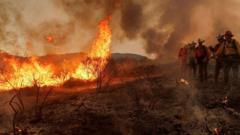A recent WHO report highlights the growing threat of heat stress in the workplace due to climate change, calling for immediate action from governments and employers. With rising temperatures impacting health and productivity, adaptation strategies are crucial for safeguarding workers, especially vulnerable populations.
WHO Sounds Alarm on Workplace Heat Stress Amid Climate Crisis
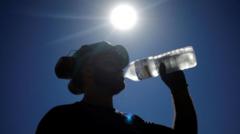
WHO Sounds Alarm on Workplace Heat Stress Amid Climate Crisis
The WHO emphasizes the urgent need for heat stress protections as climate change intensifies risks for workers, particularly in construction and agriculture.
The World Health Organization (WHO), in conjunction with the World Meteorological Organization, has issued a timely warning regarding the escalating risks of extreme heat in workplaces around the globe. With climate change leading to an increase in heatwaves, the report underscores particularly heightened vulnerabilities for construction workers and various labor sectors.
Millions of workers face heat stress, which significantly threatens their health and productivity. The report advocates for concerted efforts among governments, employers, and laborers to formulate effective adaptation strategies. “This should act as a wake-up call,” says Rüdiger Krech, WHO's director of environment, climate, and health. He emphasizes that extreme heat presents genuine health risks, such as heat-related illnesses and increased mortality rates.
The frequency and intensity of heatwaves have drastically changed, making them a regular occurrence rather than an anomaly. The last decade recorded some of the highest temperatures globally, with predictions suggesting that 2024 may surpass all previous records. In regions like the Mediterranean, average temperatures in July reached a staggering 26.68°C, while some locales in Africa and the Middle East experience extremes upwards of 50°C.
The practical impacts of these heatwaves extend beyond mere discomfort; they correlate with drops in productivity and surging accident rates. The new WHO report indicates that every 1°C rise above 20°C results in a 2% decrease in work efficiency. Recent events, such as the 2023 European heatwave, have illustrated this stark reality, showing a 7% increase in workplace accidents when temperatures exceed 30°C.
In response to the growing heat challenges, some European nations have initiated preventive measures. Italy has passed an emergency decree to shield workers from heat stress during extreme temperatures, while Switzerland has already halted construction practices during heatwaves. Organizations like the Swiss trade union Unia are advocating for workers' rights to refuse work in extreme heat conditions, emphasizing the need for safety over schedules.
The WHO report also highlights that the elderly, chronically ill, and children are particularly vulnerable during heatwaves. With schools now facing similar temperature challenges, adaptive strategies are essential for educational environments too. In Germany, schools can designate “Hitzefrei” (heat freedom) days during intense heat, allowing students to leave early. However, as these high temperatures become commonplace, educators are seeking long-term solutions, such as improved ventilation and air conditioning in school buildings.
The imperative for adaptation extends to all sectors, as the WHO stresses the necessity of collaboration among stakeholders—governments, employers, and health organizations—when formulating change. However, the resources required for these adaptations may pose a challenge at a time when many governments are reallocating their budgets toward defense. Krech warns that failing to invest in climate resilience could incur even higher costs down the line, as workplace productivity and worker health may deteriorate under the persistent threat of extreme heat.
Ultimately, as the intensity and frequency of heatwaves rise, the call for both immediate action and long-term planning in workplaces, schools, and beyond has never been more urgent.
Millions of workers face heat stress, which significantly threatens their health and productivity. The report advocates for concerted efforts among governments, employers, and laborers to formulate effective adaptation strategies. “This should act as a wake-up call,” says Rüdiger Krech, WHO's director of environment, climate, and health. He emphasizes that extreme heat presents genuine health risks, such as heat-related illnesses and increased mortality rates.
The frequency and intensity of heatwaves have drastically changed, making them a regular occurrence rather than an anomaly. The last decade recorded some of the highest temperatures globally, with predictions suggesting that 2024 may surpass all previous records. In regions like the Mediterranean, average temperatures in July reached a staggering 26.68°C, while some locales in Africa and the Middle East experience extremes upwards of 50°C.
The practical impacts of these heatwaves extend beyond mere discomfort; they correlate with drops in productivity and surging accident rates. The new WHO report indicates that every 1°C rise above 20°C results in a 2% decrease in work efficiency. Recent events, such as the 2023 European heatwave, have illustrated this stark reality, showing a 7% increase in workplace accidents when temperatures exceed 30°C.
In response to the growing heat challenges, some European nations have initiated preventive measures. Italy has passed an emergency decree to shield workers from heat stress during extreme temperatures, while Switzerland has already halted construction practices during heatwaves. Organizations like the Swiss trade union Unia are advocating for workers' rights to refuse work in extreme heat conditions, emphasizing the need for safety over schedules.
The WHO report also highlights that the elderly, chronically ill, and children are particularly vulnerable during heatwaves. With schools now facing similar temperature challenges, adaptive strategies are essential for educational environments too. In Germany, schools can designate “Hitzefrei” (heat freedom) days during intense heat, allowing students to leave early. However, as these high temperatures become commonplace, educators are seeking long-term solutions, such as improved ventilation and air conditioning in school buildings.
The imperative for adaptation extends to all sectors, as the WHO stresses the necessity of collaboration among stakeholders—governments, employers, and health organizations—when formulating change. However, the resources required for these adaptations may pose a challenge at a time when many governments are reallocating their budgets toward defense. Krech warns that failing to invest in climate resilience could incur even higher costs down the line, as workplace productivity and worker health may deteriorate under the persistent threat of extreme heat.
Ultimately, as the intensity and frequency of heatwaves rise, the call for both immediate action and long-term planning in workplaces, schools, and beyond has never been more urgent.

